-

新人教版高中英语选修2Unit 1 Science and Scientists-Learning about Language教学设计
Step 7: complete the discourse according to the grammar rules.Cholera used to be one of the most 1.__________ (fear) diseases in the world. In the early 19th century, _2_________ an outbreak of cholera hit Europe, millions of people died. But neither its cause, 3__________ its cure was understood. A British doctor, John Snow, wanted to solve the problem and he knew that cholera would not be controlled _4_________ its cause was found. In general, there were two contradictory theories 5 __________ explained how cholera spread. The first suggested that bad air caused the disease. The second was that cholera was caused by an _6_________(infect) from germs in food or water. John Snow thought that the second theory was correct but he needed proof. So when another outbreak of cholera hit London in 1854, he began to investigate. Later, with all the evidence he _7_________ (gather), John Snow was able to announce that the pump water carried cholera germs. Therefore, he had the handle of the pump _8_________ (remove) so that it couldn't be used. Through his intervention,the disease was stopped in its tracks. What is more, John Snow found that some companies sold water from the River Thames that __9__________________ (pollute) by raw waste. The people who drank this water were much more likely _10_________ (get) cholera than those who drank pure or boiled water. Through John Snow's efforts, the _11_________ (threaten) of cholera around the world saw a substantial increase. Keys: 1.feared 2.when 3. nor 4.unless 5.that/which 6.infection 7.had gathered 8.removed 9.was polluted 10.to get 11. threat

新人教版高中英语选修2Unit 1 Science and Scientists-Reading and thinking教学设计
Step 5: After learning the text, discuss with your peers about the following questions:1.John Snow believed Idea 2 was right. How did he finally prove it?2. Do you think John Snow would have solved this problem without the map?3. Cholera is a 19th century disease. What disease do you think is similar to cholera today?SARS and Covid-19 because they are both deadly and fatally infectious, have an unknown cause and need serious public health care to solve them urgently.keys:1. John Snow finally proved his idea because he found an outbreak that was clearly related to cholera, collected information and was able to tie cases outside the area to the polluted water.2. No. The map helped John Snow organize his ideas. He was able to identify those households that had had many deaths and check their water-drinking habits. He identified those houses that had had no deaths and surveyed their drinking habits. The evidence clearly pointed to the polluted water being the cause.3. SARS and Covid-19 because they are both deadly and fatally infectious, have an unknown cause and need serious public health care to solve them urgently.Step 6: Consolidate what you have learned by filling in the blanks:John Snow was a well-known _1___ in London in the _2__ century. He wanted to find the _3_____ of cholera in order to help people ___4_____ it. In 1854 when a cholera __5__ London, he began to gather information. He ___6__ on a map ___7___ all the dead people had lived and he found that many people who had ___8____ (drink) the dirty water from the __9____ died. So he decided that the polluted water ___10____ cholera. He suggested that the ___11__ of all water supplies should be _12______ and new methods of dealing with ____13___ water be found. Finally, “King Cholera” was __14_____.Keys: 1. doctor 2. 19th 3.cause 4.infected with 5.hit 6.marked 7.where 8.drunk 9.pump 10.carried 11.source 12.examined 13.polluted 14.defeatedHomework: Retell the text after class and preview its language points

新人教版高中英语选修2Unit 1 Science and Scientists-Using langauge教学设计
This happens because the dish soap molecules have a strong negative charge, and the milk molecules have a strong positive charge. Like magnets, these molecules are attracted to each other, and so they appear to move around on the plate, taking the food coloring with them, making it look like the colors are quickly moving to escape from the soap.Listening text:? Judy: Oh, I'm so sorry that you were ill and couldn't come with us on our field trip. How are you feeling now? Better?? Bill: Much better, thanks. But how was it?? Judy: Wonderful! I especially liked an area of the museum called Light Games.it was really cool. They had a hall of mirrors where I could see myself reflected thousands of times!? Bill: A hall of mirrors can be a lot of fun. What else did they have?? Judy: Well, they had an experiment where we looked at a blue screen for a while, and then suddenly we could see tiny bright lights moving around on it. You'll never guess what those bright lights were!? Bill: Come on, tell me!? Judy: They were our own blood cells. For some reason, our eyes play tricks on us when we look at a blue screen, and we can see our own blood cells moving around like little lights! But there was another thing I liked better. I stood in front of a white light, and it cast different shadows of me in every color of the rainbow!? Bill: Oh, I wish I had been there. Tell me more!? Judy: Well, they had another area for sound. They had a giant piano keyboard that you could use your feet to play. But then, instead of playing the sounds of a piano, it played the voices of classical singers! Then they had a giant dish, and when you spoke into it, it reflected the sound back and made it louder. You could use it to speak in a whisper to someone 17 meters away.? Bill: It all sounds so cool. I wish I could have gone with you? Judy: I know, but we can go together this weekend. I'd love to go there again!? Bill: That sounds like a great idea!

新人教版高中英语选修2Unit 2 Bridging Cultures-Discovering useful structures教学设计
The grammar of this unit is designed to review noun clauses. Sentences that use nouns in a sentence are called noun clauses. Nominal clauses can act as subject, object, predicate, appositive and other components in compound sentences. According to the above-mentioned different grammatical functions, nominal clauses are divided into subject clause, object clause, predicate clause and appositive clause. In this unit, we will review the three kinds of nominal clauses. Appositive clauses are not required to be mastered in the optional compulsory stage, so they are not involved.1. Guide the students to judge the compound sentences and determine the composition of the clauses in the sentence.2. Instruct students to try to learn grammar by generalizing grammar rules, controlling written practice, and semi-open oral output.3. Inspire the students to systematize the function and usage of noun clause1.Instruct students to try to learn grammar by generalizing grammar rules, controlling written practice, and semi-open oral output.2.Inspire the students to systematize the function and usage of noun clauseStep1: The teacher ask studetns to find out more nominal clauses from the reading passage and udnerline the nominal clauses.

新人教版高中英语选修2Unit 3 Food and Culture-Discovering useful structures教学设计
The newspaper reported more than 100 people had been killed in the thunderstorm.报纸报道说有一百多人在暴风雨中丧生。(2)before、when、by the time、until、after、once等引导的时间状语从句的谓语是一般过去时,以及by、before后面接过去的时间时,主句动作发生在从句的动作或过去的时间之前且表示被动时,要用过去完成时的被动语态。By the time my brother was 10, he had been sent to Italy.我弟弟10岁前就已经被送到意大利了。Tons of rice had been produced by the end of last month. 到上月底已生产了好几吨大米。(3) It was the first/second/last ... time that ...句中that引导的定语从句中,主语与谓语构成被动关系时,要用过去完成时的被动语态。It was the first time that I had seen the night fact to face in one and a half years. 这是我一年半以来第一次亲眼目睹夜晚的景色。(4)在虚拟语气中,条件句表示与过去事实相反,且主语与谓语构成被动关系时,要用过去完成时的被动语态。If I had been instructed by him earlier, I would have finished the task.如果我早一点得到他的指示,我早就完成这项任务了。If I had hurried, I wouldn't have missed the train.如果我快点的话,我就不会误了火车。If you had been at the party, you would have met him. 如果你去了晚会,你就会见到他的。

新人教版高中英语选修2Unit 3 Food and Culture-Reading and thinking教学设计
The discourse explores the link between food and culture from a foreign’s perspective and it records some authentic Chinese food and illustrates the cultural meaning, gerography features and historic tradition that the food reflects. It is aimed to lead students to understand and think about the connection between food and culture. While teaching, the teacher should instruct students to find out the writing order and the writer’s experieces and feelings towards Chinese food and culture.1.Guide the students to read the text, sort out the information and dig out the topic.2.Understand the cultural connotation, regional characteristics and historical tradition of Chinese cuisine3.Understand and explore the relationship between food and people's personality4.Guide the students to use the cohesive words in the text5.Lead students to accurately grasp the real meaning of the information and improve the overall understanding ability by understanding the implied meaning behind the text.1. Enable the Ss to understand the structure and the writing style of the passage well.2. Lead the Ss to understand and think further about the connection between food and geography and local character traits.Step1: Prediction before reading. Before you read, look at the title, and the picture. What do you think this article is about?keys:It is about various culture and cuisine about a place or some countries.

新人教版高中英语选修2Unit 5 First Aid-Discovering useful structures教学设计
You have no excuse for not going.你没有理由不去。He was punished for not having finished his homework.他因未完成作业而受到惩罚。2.动词ing形式复合结构由物主代词或人称代词宾格、名词所有格或普通格加动词ing,即“sb./sb.'s+doing”构成。动词ing形式的复合结构实际上是给动词ing形式加了一个逻辑主语。动词ing形式的复合结构有四种形式:①形容词性物主代词+动词ing②名词所有格+动词ing③代词宾格+动词ing④名词+动词ingHer coming to help encouraged all of us.她来帮忙鼓舞了我们所有人。The baby was made awake by the door suddenly shutting.这个婴儿被突然的关门声吵醒了。Can you imagine him/Jack cooking at home?你能想象他/杰克在家做饭的样子吗?无生命名词无论是作主语还是作宾语都不能用第②种形式。Tom's winning first prize last year impressed me a lot.汤姆去年得了一等奖使我印象深刻。Do you mind my/me/Jack's/Jack leaving now?你介意我/杰克现在离开吗?Excuse me for my not coming on time.很抱歉我没能按时来。His father's being ill made him worried.他父亲病了,他很担心。We are looking forward to the singer's/the singer to give us a concert.我们盼望着这位歌手来给我们举办一场演唱会。
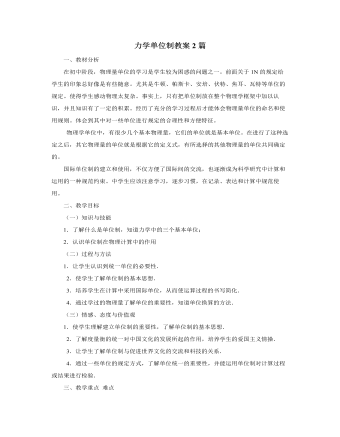
人教版新课标高中物理必修1力学单位制教案2篇
一、教材分析在初中阶段,物理量单位的学习是学生较为困惑的问题之一。前面关于1N的规定给学生的印象总好像是有些随意。尤其是牛顿、帕斯卡、安培、伏特、焦耳、瓦特等单位的规定。使得学生感动物理太复杂。事实上,只有把单位制放在整个物理学框架中加以认识,并且知识有了一定的积累。经历了充分的学习过程后才能体会物理量单位的命名和使用规则。体会到其中对一些单位进行规定的合理性和方便特征。物理学单位中,有很少几个基本物理量,它们的单位就是基本单位。在进行了这种选定之后,其它物理量的单位就是根据它的定义式,有所选择的其他物理量的单位共同确定的。国际单位制的建立和使用,不仅方便了国际间的交流,也逐渐成为科学研究中计算和运用的一种规范约束。中学生应该注意学习,逐步习惯,在记录、表达和计算中规范使用。二、教学目标(一)知识与技能1.了解什么是单位制,知道力学中的三个基本单位;2.认识单位制在物理计算中的作用
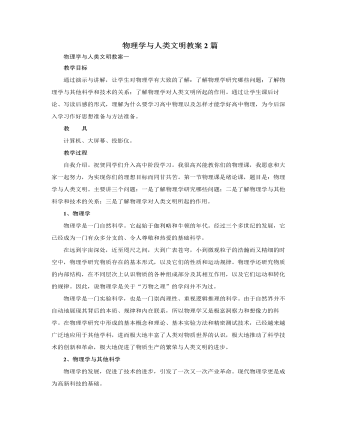
人教版新课标高中物理必修1物理学与人类文明教案2篇
1. 课前观看视频《物理学与人类文明》2. 分组讨论,派代表发言,谈学习感受。主要是物理的地位,物理的学习方法。3. 高中物理与初中物理在内容和方法上的区别高中物理除了现象、概念和规律之外还应该关注研究问题的方法,学会从先想到抽象,从定性到定量研究问题,学会用数学方法解决物理问题,学会实验探究,学会独立分析问题解决问题的思维习惯。4. 高中物理学习的基本要求高中物理学习应该“重视实验,勤于思考”和“经历过程,体验方法”。高中物理学习与初中物理学习虽然有一定区别,但也不是孤立的,要继续坚持初中物理学习中积累的学习方法和体会,重视从正反两个方面加以总结和提炼,做到:(1) 认真阅读,学会自学要学好物理,就要认真阅读课本。阅读课本是要抓住关键词语,弄清语句间的逻辑顺序和因果关系,领会文章段落所表达的物理内容,掌握课本叙述物理问题的表达方法。
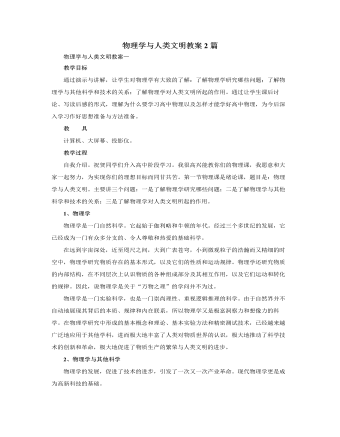
人教版新课标高中物理必修1物理学与人类文明教案2篇
八、物理学的基础地位及物理学对人类文明、社会进步的影响。(1) 情景一:磁悬浮实验:找两个空心的圆柱片磁铁,同名磁极相对,穿在同一根竹筷上,用手压下上面的磁铁,松手观察它的运动情况。问题1:上面的磁铁为什么会跳起来,为什么会悬浮在下面的磁铁上方?问题2:根据这个实验,你会想到那一种交通工具?总结:人们就是从磁悬浮现象中得到启发,进行磁悬浮列车的研究和制造的,这说明物理学在推动社会进步、人类文明方面起到推动作用。(2) 情景二:感应起电和火花放电实验:用感应起电机或感应圈产生火花放电,让学生观察现象,闻气味,然后联想生活实例。还可以用一张纸试着挡住放电的弧光,最好能引燃纸张,说明雷击引起火灾的现象。问题1:你看、听到了什么现象?问题2:根据这个实验,你会想到那一种自然现象?问题3:放电发生在什么地方?为什么建筑物上方都有尖尖的设置,是干什么用的?问题4:你闻到什么气味了吗?
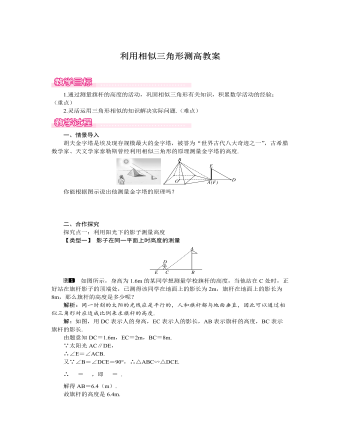
北师大初中数学九年级上册利用相似三角形测高2教案
[想一想]同学们经历了上述三种方法,你还能想出哪些测量旗杆高度的方法?你认为最优化的方法是哪种?思路点拔:1、如果旗杆周围有足够地空地使旗杆在太阳光照射下影子都在平地上,并能测出影子的长度,那么,可以在平地垂直树一根小棒,等到小棒的影子恰好等于棒高时,再量旗杆的影子,此时旗杆的影子长度就是这个旗杆的高度.2、可以采用立一个已知长度的参照物在旗杆旁照相后量出照片中旗杆与参照物的长度根据线段成比例来进行计算.3、拿一根知道长度的直棒,手臂伸直,不断调整自己的位置,使直棒刚好完全挡住旗杆,量出此时人到旗杆的距离、人手臂的长度和棒长,就可以利用三角形相似来进行计算.等等.第四环节 课堂小结1、本节课你学到了哪些知识?2、在运用科学知识进行实践过程中,你是否想到最优的方法?3、在与同伴合作交流中,你对自己的表现满意吗?第五环节 布置作业,反思提炼
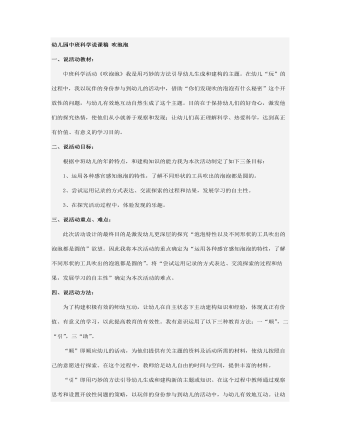
幼儿园中班科学说课稿 吹泡泡
为了构建积极有效的师幼互动,让幼儿在自主状态下主动建构知识和经验,体现真正有价值、有意义的学习,以此提高教育的有效性。我有意识运用了以下三种教育方法:一“顺”,二“引”,三“助”。 “顺”即顺应幼儿的活动,为他们提供有关主题的资料及活动所需的材料,使幼儿按照自己的意愿进行探索。在这个过程中,教师给足幼儿自由的时间与空间,提供丰富的材料。 “引”即用巧妙的方法引导幼儿生成和建构新的主题或知识。在这个过程中教师通过观察思考和设置开放性问题的策略,以玩伴的身份参与到幼儿的活动中,与幼儿有效地互动。让幼儿在“玩”中学,在学中“玩”。 “助”即教师在适当的时候“助”幼儿一臂之力,对幼儿进行点拔,借助当时的情景、材料,直接地提出主题,把幼儿的学习兴趣推向深入。
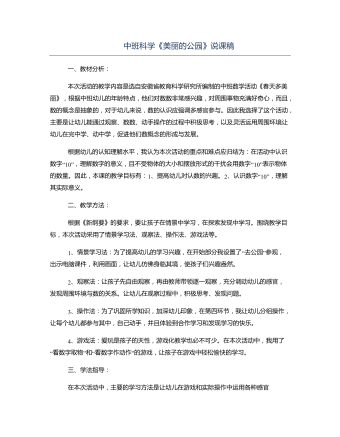
中班科学《美丽的公园》说课稿
本次活动的教学内容是选自安徽省教育科学研究所编制的中班数学活动《春天多美丽》,根据中班幼儿的年龄特点,他们对数数非常感兴趣,对周围事物充满好奇心,而且,数的概念是抽象的,对于幼儿来说,数的认识应强调多感官参与。因此我选择了这个活动,主要是让幼儿能通过观察、数数、动手操作的过程中积极思考,以及灵活运用周围环境让幼儿在完中学、动中学,促进他们数概念的形成与发展。根据幼儿的认知理解水平,我认为本次活动的重点和难点应归结为:在活动中认识数字“10”,理解数字的意义,且不受物体的大小和摆放形式的干扰会用数字“10”表示物体的数量。因此,本课的教学目标有:1、提高幼儿对认数的兴趣。2、认识数字“10”,理解其实际意义。
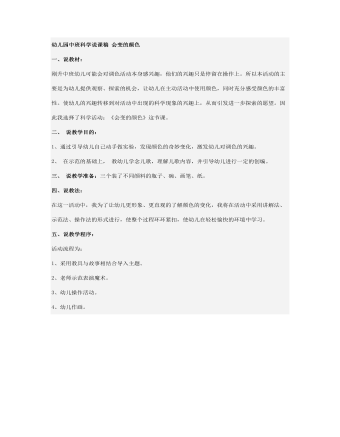
幼儿园中班科学说课稿 会变的颜色
刚升中班幼儿可能会对调色活动本身感兴趣,他们的兴趣只是停留在操作上。所以本活动的主要是为幼儿提供观察、探索的机会,让幼儿在主动活动中使用颜色,同时充分感受颜色的丰富性。使幼儿的兴趣转移到对活动中出现的科学现象的兴趣上,从而引发进一步探索的愿望。因此我选择了科学活动:《会变的颜色》这节课。
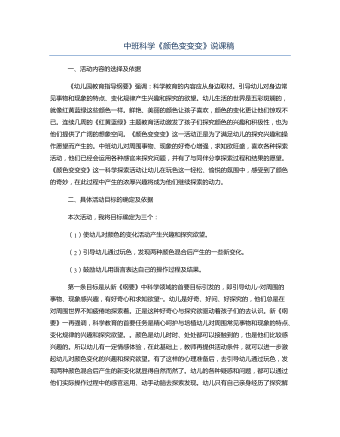
中班科学《颜色变变变》说课稿
《幼儿园教育指导纲要》强调:科学教育的内容应从身边取材。引导幼儿对身边常见事物和现象的特点、变化规律产生兴趣和探究的欲望。幼儿生活的世界是五彩斑斓的,就像红黄蓝绿这些颜色一样。鲜艳、美丽的颜色让孩子喜欢,颜色的变化更让他们惊叹不已。连续几周的《红黄蓝绿》主题教育活动激发了孩子们探究颜色的兴趣和积极性,也为他们提供了广阔的想象空间。《颜色变变变》这一活动正是为了满足幼儿的探究兴趣和操作愿望而产生的。中班幼儿对周围事物、现象的好奇心增强,求知欲旺盛,喜欢各种探索活动,他们已经会运用各种感官来探究问题,并有了与同伴分享探索过程和结果的愿望。《颜色变变变》这一科学探索活动让幼儿在玩色这一轻松、愉悦的氛围中,感受到了颜色的奇妙,在此过程中产生的浓厚兴趣将成为他们继续探索的动力。
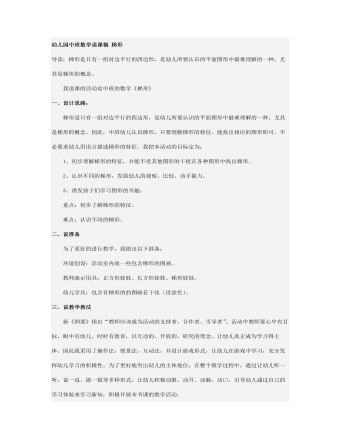
幼儿园中班数学说课稿 梯形
新《纲要》指出“教师应该成为活动的支持者、合作者、引导者”。活动中教师要心中有目标,眼中有幼儿,时时有教育,以互动的、开放的、研究的理念,让幼儿真正成为学习得主体。因此我采用了操作法,情景法,互动法,并设计游戏形式,让幼儿在游戏中学习,充分发挥幼儿学习的积极性。为了更好地突出幼儿的主体地位,在整个教学过程中,通过让幼儿听一听,说一说、做一做等多种形式,让幼儿积极动眼、动耳、动脑、动口,引导幼儿通过自己的学习体验来学习新知,积极开展本节课的教学活动。
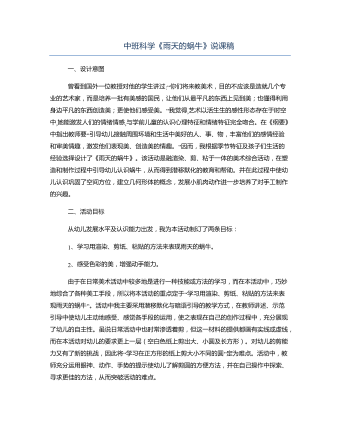
中班科学《雨天的蜗牛》说课稿
曾看到国外一位教授对他的学生讲过:“你们将来教美术,目的不应该是造就几个专业的艺术家,而是培养一批有美感的国民,让他们从最平凡的东西上见到美;也懂得利用身边平凡的东西创造美;更使他们感受美。”我觉得,艺术以活生生的感性形态存在于时空中,她能激发人们的情绪情感,与学前儿童的认识心理特征和情绪特征完全吻合。在《纲要》中指出教师要“引导幼儿接触周围环境和生活中美好的人、事、物,丰富他们的感情经验和审美情趣,激发他们表现美、创造美的情趣。”因而,我根据季节特征及孩子们生活的经验选择设计了《雨天的蜗牛》。该活动是融渲染、剪、粘于一体的美术综合活动,在塑造和制作过程中引导幼儿认识蜗牛,从而得到潜移默化的教育和帮助。并在此过程中使幼儿认识巩固了空间方位,建立几何形体的概念,发展小肌肉动作进一步培养了对手工制作的兴趣。

中班科学《番茄浮起来》说课稿
水是我们日常生活中不可缺少的,我们每天都离不开它,每个人离不开它,正因为水与我们生活的密切性,小朋友很早就接触并认识了它,可以说,幼儿天生就爱玩水,在玩水的过程中,发现了很多有趣的而又新奇的现象。小番茄也是小朋友们早已认识并喜爱的水果。我还采用了盐用辅助材料,让幼儿观察物体在清水和盐水两种不同状态的奇妙现象,《新纲要》中指出,科学教育应密切联系幼儿的实际生活进行,利用身边的事物与现象作为科学探索的对象。因此,我选择了小番茄在清水和盐水的不同的奇特现象,作为幼儿科学教育内容,在活动中我还为幼儿提供了简单而可操作的材料,用小番茄做两个不同的实验,为每个幼儿都能运用仔细观察运用实验得真知的方式进行探索提供活动的条件,通过引导幼儿积极参加小组讨论、探索等方式,培养了幼儿合作学习的意识和能力,学会了用多种方式表现、交流、分享探索的过程和结果。
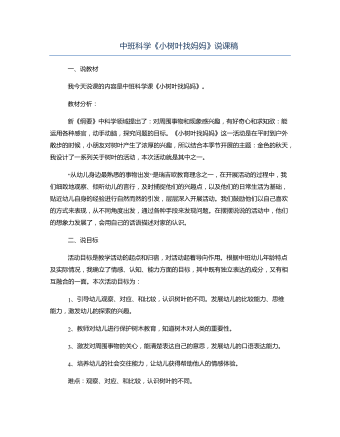
中班科学《小树叶找妈妈》说课稿
新《纲要》中科学领域提出了:对周围事物和现象感兴趣,有好奇心和求知欲:能运用各种感官,动手动脑,探究问题的目标。《小树叶找妈妈》这一活动是在平时到户外散步的时候,小朋友对树叶产生了浓厚的兴趣,所以结合本季节开展的主题:金色的秋天,我设计了一系列关于树叶的活动,本次活动就是其中之一。“从幼儿身边最熟悉的事物出发”是瑞吉欧教育理念之一,在开展活动的过程中,我们细致地观察、倾听幼儿的言行,及时捕捉他们的兴趣点,以及他们的日常生活为基础,贴近幼儿自身的经验进行自然而然的引发,层层深入开展活动。我们鼓励他们以自己喜欢的方式来表现,从不同角度出发,通过各种手段来发现问题。在摆摆说说的活动中,他们的想象力发展了,会用自己的话语描述对家的认识。
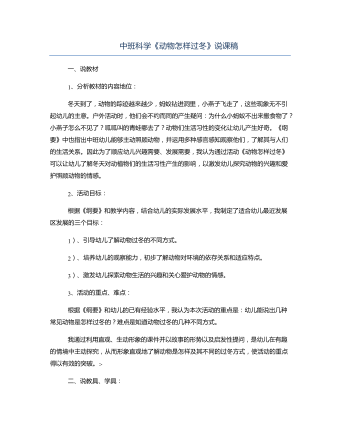
中班科学《动物怎样过冬》说课稿
冬天到了,动物的踪迹越来越少,蚂蚁钻进洞里,小燕子飞走了,这些现象无不引起幼儿的主意。户外活动时,他们会不约而同的产生疑问:为什么小蚂蚁不出来搬食物了?小燕子怎么不见了?呱呱叫的青蛙哪去了?动物们生活习性的变化让幼儿产生好奇。《纲要》中也指出中班幼儿能够主动照顾动物,并运用多种感官感知观察他们,了解其与人们的生活关系。因此为了顺应幼儿兴趣需要、发展需要,我认为通过活动《动物怎样过冬》可以让幼儿了解冬天对动植物们的生活习性产生的影响,以激发幼儿探究动物的兴趣和爱护照顾动物的情感。

